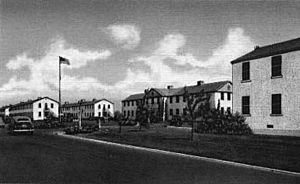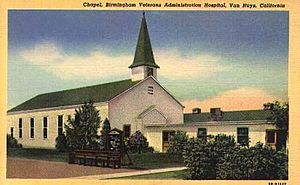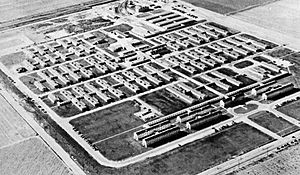Birmingham General Hospital, California facts for kids
Quick facts for kids Birmingham General Hospital |
|
|---|---|

Birmingham General Hospital, 1945
|
|
| Location | Van Nuys, California |
| Area | 131 acres |
| Built | Open August 24, 1943 (closed 1950) |
| Architect | US Army |
| Lua error in Module:Location_map at line 420: attempt to index field 'wikibase' (a nil value). | |
Birmingham General Hospital was a special hospital built by the US Army during World War II. It was located in Van Nuys, California. The hospital was built between 1942 and 1943. Its main job was to care for soldiers returning home from fighting overseas. The first patient arrived on August 24, 1943. The hospital was very large, with 1777 beds. These beds were spread out in many single-story buildings across a huge 131-acre area.
Contents
A Hospital for Heroes: Birmingham General Hospital
When it first opened, Birmingham General Hospital was briefly called Van Nuys General Hospital. But it was soon renamed after Brigadier General Henry Patrick Birmingham. He was an important person in the U.S. Army Medical Corps. The War Department approved building the hospital on August 24, 1943. The land it was built on used to be farmland.
The hospital had 80 single-story buildings. They were made of brick and some stucco. It was more than just a place for beds. The hospital also had a chapel, a special pool for recovery, a gym, a fire station, and even a bomb shelter. There was a kitchen, a movie theater, and courts for racquetball and handball. It even had its own street car station!
A special part of the hospital was for Prisoners of War (POWs). About 40 Italian POWs from the North African campaign volunteered to help at the hospital.
The Army hospital helped soldiers with many different health needs. They cared for veterans with general illnesses. They also helped those with rheumatic fever. Special care was given to soldiers who had lost the use of their legs. This included those who could not move their arms and legs (quadriplegic) or just their legs (paraplegic). They also offered support for mental health challenges.
By 1944, a new "wonder drug" called Penicillin was being made in large amounts. The hospital used this new medicine to help many veterans. It was also one of the first places to use an antibiotic ointment. This ointment helped patients with infected broken bones. The hospital also had a special section for women veterans. These included women from WAVES, the Women's Army Corps, and Army nurses.
For soldiers returning home, 800 beds were used for medical check-ups. This helped prepare them for leaving the military. The first leader of the hospital was Colonel Alvin C. Miller. He came from the Pearl Harbor Army hospital. Jack W. Gregory was in charge of medical recovery programs. Birmingham General Hospital even had a unit to change cars. This allowed veterans who had lost the use of their legs to drive using only their hands. Famous actress Susan Peters received one of these special cars after an accident.
From Hospital to School: A New Chapter
After the war ended, on March 31, 1946, the hospital changed hands. It was given to the Veterans Administration. It was then renamed the Birmingham Veterans Administration Hospital. A group called the Paralyzed Veterans of America was actually started at this hospital.
The VA Hospital closed in 1950. The veterans staying there moved to another hospital in Long Beach. In 1952, the hospital land was sold to the Los Angeles City Schools for just $1.00!
In 1953, Birmingham High School opened on the old hospital grounds. It is now called Birmingham Community Charter High School (BCCHS). It served students from seventh to twelfth grade. Mrs. Albert Zoraster had the idea to use the old hospital as a school. Congressman Joseph F. Holt helped make her idea come true. The school's first principal, Dr. John I. Abbott, quickly turned the old hospital into a school. For example, the hospital's chapel became a drama classroom. Some of the original hospital buildings and old pools are still on the high school campus today. Part of the land is also used for William Mulholland Middle School.
Dr. Ernest Bors and Spinal Cord Care
In 1945, the US Army opened the first Spinal Cord Injury Center at Birmingham General Army Hospital. This center used the important work of Doctor Ernest Bors. He was a top expert in treating spinal cord injuries. Dr. Bors created a special way of treating these injuries. It involved many different types of doctors working together. This approach is still used in care centers today. At Birmingham General Hospital, Dr. Ernest Bors treated up to 220 veterans. Doctors from all over the world visited the hospital to learn these new medical techniques.
Hollywood Visits the Hospital
The hospital was only about 13 miles from Hollywood. Because of this, many famous Hollywood actors and actresses came to visit the soldiers. Radio personalities also visited the hospital often. In late 1944, the famous Jack Benny Christmas radio show was even broadcast from the hospital!
Many well-known stars regularly visited the hospital to cheer up the troops. These included:
- Ronald Reagan
- Anne Jeffreys
- Basil Rathbone
- Mary Pickford
- Linda Darnell
- Al Pearce
- Charles Laughton
- June Haver
- Jimmy Stewart
- Bagelman Sisters
- Clarence Nash
- The Charioteers
- Bob Hope
The hospital was also used in movies! The 1950 Hollywood movie The Men was filmed there. This was Marlon Brando's first movie. He played a World War II veteran who was injured in combat. To prepare for his role, Brando lived in a wheelchair for several weeks among the hospital's patients.
Birmingham General Hospital was also mentioned by its real name in the 1950 movie Backfire. This movie was inspired by the important work done at the hospital's Spinal Cord Injury Center. In the movie, the main actor plays an injured veteran who falls in love with a Birmingham General Hospital nurse.
Desi Arnaz, a famous entertainer, was stationed at Birmingham General Hospital during the war. He entertained the troops there with the United Service Organizations (USO). Arnaz had a bad knee, so he was transferred to the US Army Medical Corps. He also helped coordinate the visits from other stars. Arnaz was discharged from the Army on November 16, 1945.
The Idea Behind "This Is Your Life"
The popular TV show This Is Your Life actually started as an idea for a radio show. It was meant for a veteran at the hospital. The show was created by Ralph Edwards in 1948. The US Army asked Edwards to "do something" special for soldiers with leg injuries at the hospital.
On This Is Your Life, the host would surprise someone. Then, guests from that person's life would appear in front of an audience. These guests could be co-workers, friends, or family. A veteran who was having a tough time was chosen as the first person for a test show. This test was done on another show called Truth or Consequences. It was a huge success! Because of this, This Is Your Life became its own popular show.




